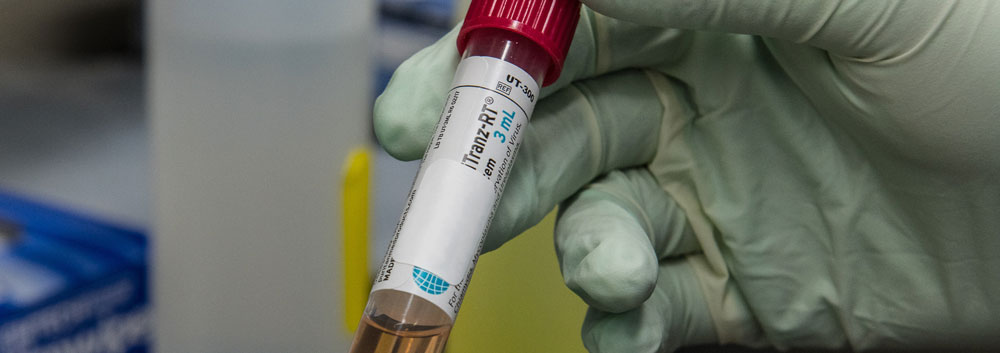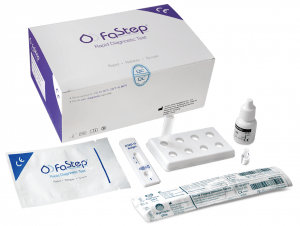The primary benefit of COVID-19 rapid antigen tests is, as the name suggests, speed. A COVID diagnosis can be obtained in under 15 minutes with point-of-care antigen tests such as Aurora’s COVID-19 Antigen Rapid Test Cassette. The tradeoff, when considered against the “gold standard” PCR test, is a comparatively low accuracy. However, despite a common misconception to the contrary, even PCR tests are not 100% accurate, so it is important to understand the relative accuracy of these tests and also what “accuracy” means in the various contexts which it is used when discussing COVID-19 testing.
COVID Test False Negatives
A false negative is usually what people colloquially using the term “accuracy” are referring to when discussing COVID diagnostic testing. PCR tests and antigen tests can both give false negatives. The primary factor in determining a test’s likelihood of providing a false negative is its sensitivity: the amount of virus which needs to be present in order for the test to register a positive result.
Various studies of PCR tests have shown varying degrees of accuracy. A study in the Annals of Internal Medicine showed that PCR tests have widely varying false negative rates depending on when the test is taken during the course of infection, which makes sense due to a highly varying viral load over the progression of infection. The study found a false negative rate of 100% at 4 days before the onset of symptoms and never demonstrated a false negative better than 20%. A separate study in the journal “Emerging Microbes and Infections” showed that the commonly used RT-PCR diagnostic methods had an 84% false negative rate and even a more sensitive “droplet digital PCR” method only brought that down to 37%. Another study comparing different PCR methods showed broadly similar results. In general, the most commonly used RT-PCR tests are good at detecting infection under situations of high viral load, but it is likely they still miss a lot of cases, especially asymptomatic cases where viral load is generally lower.
COVID antigen test accuracy has usually been studied relative to RT-PCR testing. Taking advantage of the ubiquitous testing performed by some college campuses, the CDC performed a large-scale study on one antigen test and found that the positive predictive value relative to RT-PCR (in other words, the number of cases found positive by RT-PCR which were detected by the antigen test) was 33.3% for asymptomatic patients, and 94.1% for symptomatic patients. This shows that antigen tests can come very close to matching the reliability of RT-PCR tests for symptomatic cases, when viral load is the highest.
The sensitivity of COVID tests – both PCR and antigen tests – also depends on the method by which the patient is sampled. Nasopharyngeal swabs sample an area of relatively high viral load in infected patients, and therefore are much more sensitive than saliva tests. (Sampling done by performing bronchoalveolar lavage results in even higher sensitivity.)

COVID Test False Positives
Another factor in COVID antigen test accuracy is false positives; situations where the test result indicates infection when there really is none. There is little scientific reason for false positives to be a concern; if viral particles are not present, the test should not give a positive result. That largely holds true. Both PCR tests and antigen tests very rarely report false positives. In the instances where false positives occur, it is generally assumed to be due to contamination caused by poor sample handling rather than due to the test itself.
In a large population where COVID prevalence is low, however, even very low instances of false positives can lead to a low positive predictive value, or PPV. For example, a test with 99% specificity used in a population where there was 4% prevalence would have a positive predictive value of roughly 80%, meaning one in five positive results would be false positives (4 / 100 tests would report as positive correctly, and 1 / 100 would be a false positive; we ignore false negatives such as not to complicate the example). Therefore, the CDC recommends that confirmatory RT-PCR testing is performed within 48 hours in areas where prevalence is low.
The term “specificity” could also be used to refer to the ability of the test to detect only the specific virus in question. This is generally not a concern. While antigen tests often cannot discern between SARS-CoV-2 (the COVID-19 coronavirus) and SARS-CoV-1 (the original SARS coronavirus from 2002), SARS-CoV-1 is not currently present in the human population. Other coronaviruses, such as the species responsible for approximately 15% of common colds, are sufficiently distinct that they do not cause false positives in antigen testing. As PCR testing looks for specific RNA sequences which are unique to SARS-CoV-2, they also are not prone to false positives from other coronaviruses.

How Accurate is Aurora’s Antigen Rapid Test
Aurora’s COVID-19 Antigen Rapid Test Cassette performs well, with an 97.7% relative sensitivity and 99.1% relative specificity. It is also highly reproducible, with a 99% positive percent agreement. In other words, if a patient tests positive, there is a 99% likelihood that a second test would provide the same result.
Conclusion
The reliability of antigen and PCR tests both depend on the same factor: the viral load of the patient. There is no denying that PCR tests are more sensitive, and this difference in sensitivity is especially noticeable when trying to detect asymptomatic cases. The relatively fast, easy, and inexpensive antigen tests nevertheless are a valuable tool for situations when an answer is needed quickly, when testing needs to be performed frequently, and / or when large populations need to be screened. Both PCR and antigen tests for COVID have roles to play in combating the global pandemic.


